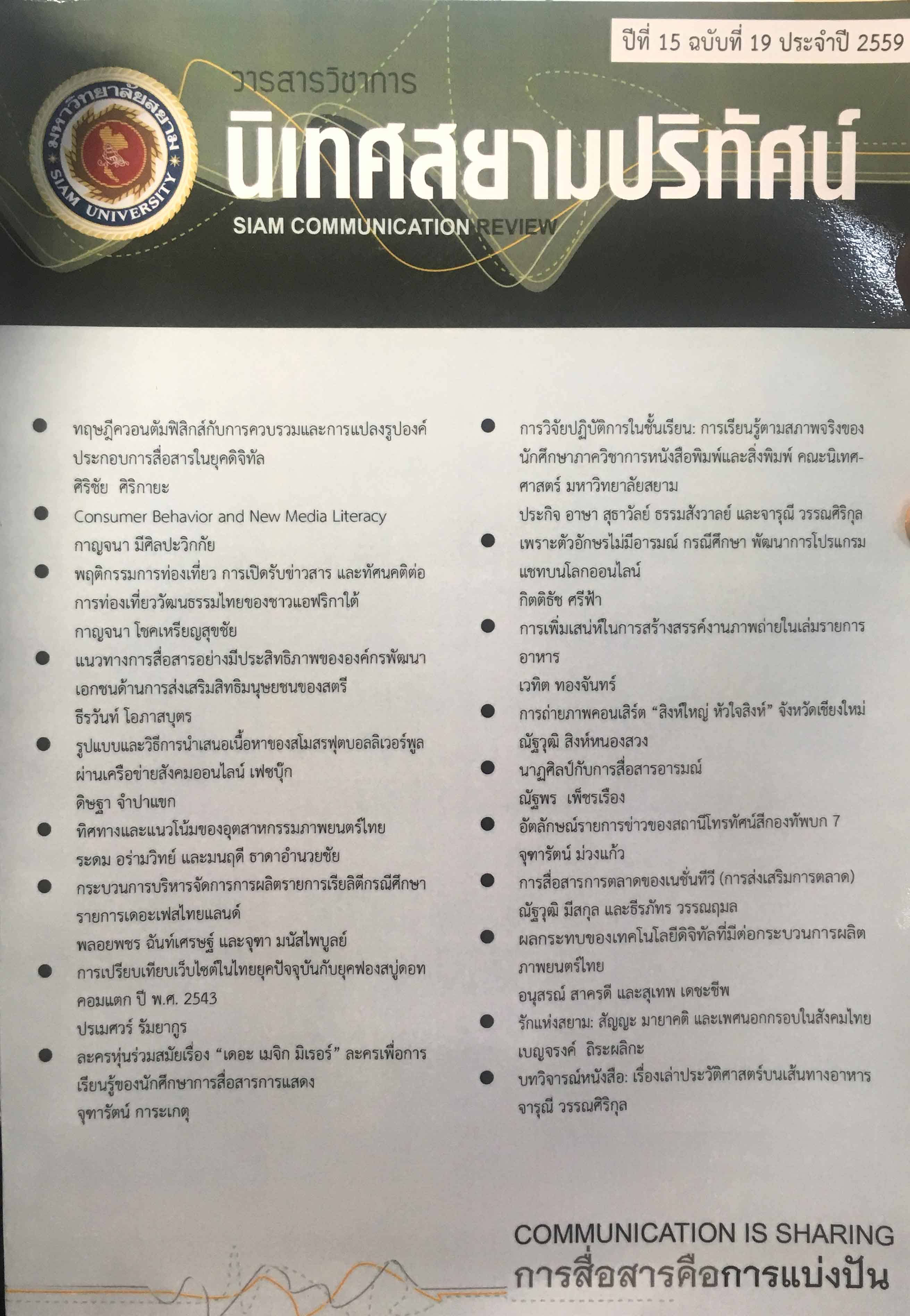The Impacts of Digital Technology upon Thai Filmmaking Process
Main Article Content
Abstract
This research aims to study 1) the impacts of digital technology on the process of Thai filmmaking, during the production and post-production stages, 2) the impacts of digital technology on the process of Thai independent film production, and 3) the impact on the process of Thai in-current film production. The research was qualitatively conducted by analyzing related foreign academic journals, foreign academic films, and reliable online journals. The data was collected through interviewing groups of independent film directors and in-current film makers in Thailand. The results shows that, according to similar opinions from groups of independent film directors and in-current film makers in Thailand, the impacts of digital technology on the process of Thai film production were 1) budget of production being decreased due to lower cost of film production process, 2) increased variety of scripts and stories being written and possible interpretation, 3) changes in working format during the pre-production stage, 4) changes in production design and art direction resulting in improvements of make-up styles, 5) changes in film directing styles, and 6) the changes of cinematography techniques. The results also shows that the impacts of digital technology on post-production filming process involves reduced steps required for certain tasks, such as developing photographic films, telescening data files for editing, film printing step for projecting, film editorial, color grading, and visual effects. This is due to 1) the shortened process of film editorial, consequently resulting in more difficulty with file management, 2) the shortened process of color grading, while accuracy and efficiency is increased, being more up-to-date, and 3) the changes in applying visual effects with more realism and efficiency with less time used.
Article Details
References
ก่อ สวัสดิพาณิชย์. (2517). มารู้จักกับเทคโนโลยีทางการศึกษากันเถอะ. สืบค้นจาก http://www.kmutt.ac.th/av/HTML/techno/note.htm
กิตติศักดิ์ สุวรรณโภคิน. (2546). กระบวนการผลิตภาพยนตร์. (เอกสารประกอบคำ?สอน). กรุงเทพฯ: วิทยาลัยนวัตกรรมอุดมศึกษา มหาวิทยาลัยธรรมศาสตร์. (อัดสำ?เนา)
ฉลองรัฐ เฌอมาลย์ชลมารค. (2557). ภาพยนตร์ไทยกับยุคเปลี่ยนผ่านเทคโนโลยี. นิเทศศาสตร์ปริทัศน์, 18(1),8 - 19.
เชาวลิต โกกิจ. (2554). การบริการการผลิตภาพยนตร์ต้นทุนตํ่า (วิทยานิพนธ์ปริญญามหาบัณฑิต). กรุงเทพฯ:มหาวิทยาลัยธรรมศาสตร์.
ดนุวัฒน์ เจตนา. (2553). การวิเคราะห์แนวโน้มการเปลี่ยนแปลงการถ่ายทำภาพยนตร์ระบบฟิล์มเป็นระบบดิจิทัลในประเทศไทย (วิทยานิพนธ์ปริญญามหาบัณฑิต ไม่ได้ตีพิมพ์). จุฬาลงกรณ์มหาวิทยาลัย, กรุงเทพฯ.
เทคโนโลยีการผลิตภาพยนตร์. (2559). การผลิตภาพยนตร์. สืบค้นจากhttps://www.facebook.com/MovieMakingTechnology/?fref=ts
ธิดา ผลิตผลการพิมพ์. (2559). หนังนอกกระแสในช่วงเวลาที่กลายเป็นเรื่องตามกระแส. สืบค้นจาก http://www.manager.co.th/Marsmag/ViewNews.aspx?NewsID=9590000003613
บรรจง โกศัลวัฒน์. (2545). ศิลปะการแสดงภาพยนตร์ โทรทัศน์ และละคร. กรุงเทพฯ: มหาวิทยาลัยธรรมศาสตร์.
ผู้จัดการออนไลน์. (2554, 1 ธันวาคม). ภาพยนตร์ดิจิตอลทดแทน โลกเซลลูลอยด์ภายในปี 2015. สืบค้นจาก http://www.manager.co.th/iBizChannel/ ViewNews.aspx? NewsID=9540000153328
พรสิทธิ์ พัฒนานุรักษ์. (2526). ปัจจัยที่มีอิทธิพลต่อความน่าเชื่อถือของผู้ส่งสาร: การศึกษาความคิดเห็นของเกษตรกรในเขตรังสิต (วิทยานิพนธ์ปริญญามหาบัณฑิต ไม่ได้ตีพิมพ์). จุฬาลงกรณ์มหาวิทยาลัย, กรุงเทพฯ.
พรสิทธิ์ พัฒนานุรักษ์. (2543). ความรู้เบื้องต้นเกี่ยวกับภาพนิ่งและภาพยนตร์ (พิมพ์ครั้งที่ 13). นนทบุรี: มหาวิทยาลัยสุโขทัยธรรมาธิราช.
มาโนช ชุ่มเมืองปัก. (2549). ภาพยนตร์. (เอกสารประกอบคำสอน). กรุงเทพฯ: มหาวิทยาลัยธุรกิจบัณฑิตย์. (อัดสำเนา)
สมศักดิ์ ชาติน้ำเพ็ชร. (2557). ปัจจัยและแนวโน้มการใช้กล้องดิจิทัลสะท้อนภาพเลนส์เดี่ยวแบบบันทึกวีดิทัศน์ (Video-DSLR) ในการถ่ายทำภาพยนตร์ (รายงานผลการวจิ ยั ). คณะเทคโนโลยสี ารสนเทศและการสือ่ สารมหาวิทยาลัยศิลปากร, เพชรบุรี
สมาพันธ์สมาคมภาพยนตร์แห่งชาติ. (2552). อุตสาหกรรมภาพยนตร์ไทย. สืบค้นจาก www.m-culture.go.th/policy/files/329/Asian.pdf
อสมท (2552). เซ็นเซอร์รับภาพ แบบ CCD และ CMOS. สืบค้นจาก http://dtv.mcot.net/mcot_one.php?dateone=1244772701
Avatar ทุ่มทุนสร้างมโหฬารที่สุดของ ทเวนตี้ เซ็นจูรี่ ฟ็อกซ์. (2552, 8 ธันวาคม). มติชนออนไลน์. สืบค้นจากhttp://www.matichon.co.th/news_detail.php?newsid=1260249884
ภาษาอังกฤษ
ARRI. (2553). Shaping the future of filmmaking. Retrieved from https://www.arri.com/corporate/about_arri/
Barton, A., Burdett, R., & Feightner, B. (2013). Motion Imaging Workflow Subcommittee. SMPTE Motion Imaging Journal: 2013 Progress Report, 122(09), 48–49.
Brown, B. (2014). The Filmmaker’s Guide to Digital Imaging. NY and London: The Focal Press.
Jeffrey A. O. & Zwerman, S. (2015). The VES Handbook of Visual Effects. (2nd ed.). NY & London: The Focal Press.
Laura, K. (1998). Film and Changing Technologies. In Hill, John. Church Gibson, Pamela (Eds.), the Oxford Guide to Film Studies, Oxford: Oxford University Press.
Russell, H. M. (1993). Instructional Media and Technologies for Learning. NY & London: The Focal Press.
Verwaest, M., Overmeire, L., Mannens, E., & Leeune, C. (2014, October). The Case for Electronic Script-Based Collaboration. SMPTE Motion Imaging Journal: Evolving Media Workflows, 2014, 27–32.
Vivian, J. (2002). The Media of Mass communication. Boston: Allyn and Bacon.
Wheeler, P. (2003). High Definition and 24P Cinematography. Oxford: Focal Press


